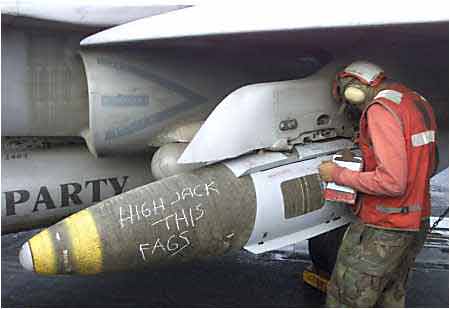ARLINGTON, VA. – A piece of heavy U.S. munitions, made famous by a mistakenly published 2001 Associated Press photo, exploded Sunday in Kandahar province, Afghanistan, after being buried for 10 years, killing two civilians.

“As always we are enormously sorry for any and all civilian casualties and take great pains to avoid them,” read Pentagon Press Secretary George Little from a statement. “These deaths play no part in winning hearts and minds in the struggle to train Afghans to defend their own sovereignty, and we extend our sympathies to the families of those involved.”
Asked about what could have led to the spontaneous detonation of the bomb, Mr. Little detailed the findings of Army investigators. Pentagon teams, working round the clock, concluded that the two Afghans likely triggered the dormant bomb through a mutual stamping on precise locations on the sand above the bomb.
“Military police,” said Mr. Little, “suggest that coordinated fouetté jetés, perhaps synchronized revoltades, or maybe just the conclusion of an old-fashioned set of skips, caused the deadly explosion — the civilian men of course holding hands, their fingertips in all likelihood resting on each other’s middle phalanxes.”
The bomb gained fame in 2001 for a photograph the Associated Press’s Jockel Finck took aboard the USS Enterprise of graffito scrawled along its surface: “High jack this fags.” AP Spokesman Jack Stokes apologized for the “journalistic error” of the publishing’s pulling back the curtain on institutional homophobia, explaining “the picture never should have gotten through, and nobody should have seen it.”
Speaking with Joshua Hammer, special to the International Herald Tribune, Shorabak district elders described the lives of the Afghan casualties — Haji Olumi, 40, and Khalid Mohammed, 18 — the ostracism their relationship received under the brutal reign of the Taliban, and very recently, the acceptance of their partnership. Said Sayyad Sabri, “Before the blessed arrival of NATO in 2001 we used to persecute the lovers all the time — throwing stones at them, threatening to kill them. But due to the tireless humanitarian enlightenment provided by our moral saviors, the International Security Assistance Force — spurred on by liberal lights in the darkness, such as Amnesty International — we had gradually grown to accept them.”
“Mr. Sabri began to speak again but abruptly choked up thinking about Olumi and Mohammed, trying to hide tears behind his simple burlap sleeves. ‘But now this. But now this! Right when we had learned to accept them. It is as though God does not wish for us to ever forget our national shame for the attacks of 9/11.’”
Speaking to The Internet Chronicle, an associate for U.S.-based military contractor DynCorp recalled meeting Mr. Mohammed in 2009 while the man served as “bacha bazi” entertainer on the company dime. Although Mr. Mohammed’s face is since obscured by mutilation from the Operation Enduring Freedom munition, the associate, who used to conduct house-to-house searches in Kandahar province, said he recognized the young man. “The darkened room was really smokey at the time, and I guess he was wearing a little less makeup a few years back,” said the DynCorp associate, as he leaned to squint at the autopsy photo on the marble-top coffee table in his McLean, Virginia living room. “But no doubt that’s the guy. A damn shame what happened to him. He had a great body. I’ll never forget the beautiful jingling of all those bells they made him wear.”
“What exactly is wrong with the fag bomb?” asked Washington Post Columnist Hank Stuever in 2001. “Wrong, that is, besides the typos,” he arrogantly continued in prudish contempt for naval enlistees, as well as obliviousness to the manual intercourse allusion. Mr. Stuever, who coined the term “fag bomb,” conducted an interview with an Admiral Stephen Pietropaoli in 2001, during which the officer characterized the slur as “not up to our standards,” despite a contemporaneous policy of systematic bigotry throughout military branches (although notoriously almost never having been enforced in the Navy).
Only slightly lower down the bastions of the socialist media, Katherine Mulvaney, then at elite Southwest Texas State University’s Daily University Star, offered her pity and condescension regarding the mind-set of U.S. servicemen. The average enlistees, Ms. Mulvaney explained, were “young kids, many or most of them without a college education, so inarticulate, they are driven to use playground epithets to express their rage over the terrorist attacks.” She wrote that Southwest Texas University’s “comfortable and enlightened” surroundings provided her due objectivity and insight through the fog of war. With a prophesying telepathy — possessed only by the likes of Edgar Cayse or L. Ron Hubbard — of the tolerant 2011 military to come, the columnist concluded, “Let’s worry about winning the war right now. We can civilize our fighters later, when the bigger job is done.”
In 2001 the “don’t ask, don’t tell” policy was still well-known among front-line troops for upholding morale, instilling group solidarity and for suppressing what Joint Chiefs of Staff Chair Martin Dempsey termed “nearly inevitable bromance.” Before the discontinuation of “don’t ask, don’t tell” servicemen could reliably bathe, defecate or even masturbate in each other’s presence, assured that any homosexuals, bisexuals, transsexuals, transgenders or hermaphrodites nearby were either actively lying, conspicuously silent about intimate partners past and present, or lacking the emotional intelligence to recognize, daresay articulate, their own deepest urges.

